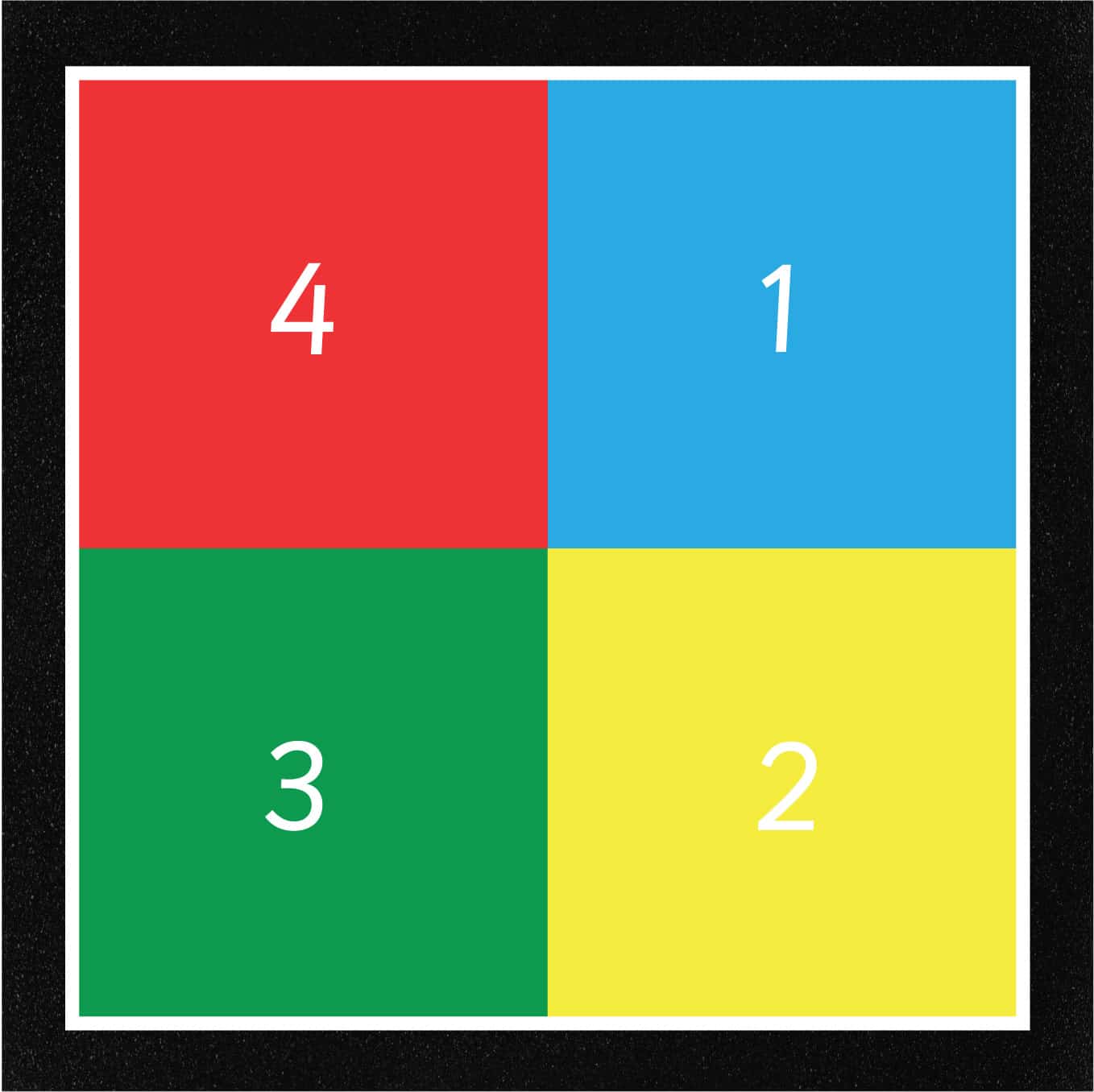The 51 Best School Playground Games For Kids
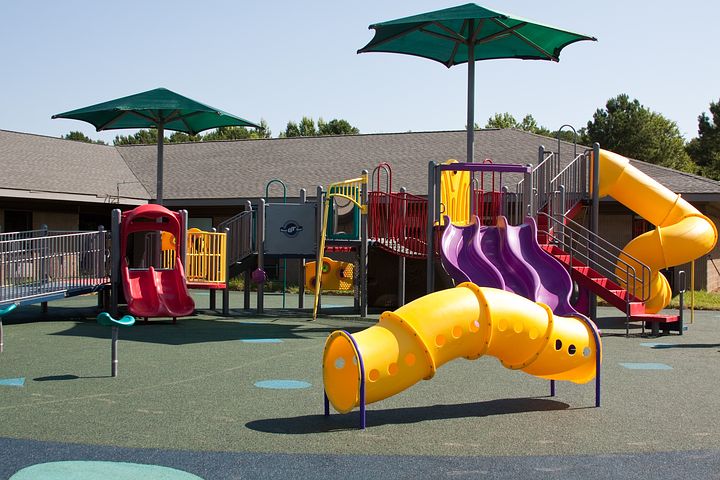
Playground markings are a fantastic yet often overlooked way of building up togetherness and unity in schools. Games, sports, and other fun activities permanently placed in your outdoor spaces can help to teach your kids the value of teamwork whenever they go out for PE, break, or lunch, and this is one of the cornerstones to positive childhood development.
We also know that creating activities that kids are going to love and engage with can be difficult. That’s why we thought we’d give you a headstart by selecting and sharing some of our favourite games with you. All the games we’ve listed can be adapted to suit the children you’re working with and all of them help encourage unity, team play, and healthy competition.
Below you will find a wide selection of games for:
1. Relay Races
Number of Players: Maximum of 30
Age Range: 4+
What the Game Teaches: Team play, fitness, and agility.
The relay race is one of the oldest and simplest Sports Day games in the book. In fact, it’s so simple it can be adjusted and changed to suit pretty much any age group, level, or sport.
How to Play the Game:
A simple example is splitting your kids up into two teams. Each team has to take it in turns to dribble a football to and from a point as fast as possible. The first team to have all their players complete the task and sit down at the start line wins! The best thing about the sports relay race is that it can be carried out in so many variations: the egg and spoon race, the sack race, a running race, skipping, hopping, jumping – pretty much any activity you can think of!
Tips for Adults: Try to mix up the sporting abilities in each team. Otherwise, if one team is naturally sportier than the other, the competition will be unbalanced and one team will suffer. So, keep the team numbers and abilities even to increase the competition.
Time to Play: Under an hour
Discover Our Vibrant Sport Court Markings

Netball
Size: 30 x 15m
£545.00 more details

Basketball
Size: 30 x 15m
£695.00 more details

Netball & Short Tennis
Size: 30 x 15 m (each Short Tennis Court is 12 x 6m)
£1,045.00 more details
2. Sports Hot Potato
Number of Players: No limit
Age Range: 5+
What the Game Teaches: How to be active, healthy competitiveness, and team encouragement.
How to Play the Game:
This game can be played with groups of any size. Split the groups into two. Each group must stand in a circle (an arms width apart from each other) and throw, kick, or pass the ball to one another. Every time a pass is successfully caught by someone, everyone in the group has to take one step backward – making the circle bigger and the game more challenging. The biggest circle after an allotted amount of time (5 minutes, for example) wins the game.
Tips for Adults: Otherwise known as ‘sports hot potato’, catching sports are fantastic for developing reflexes, reaction times, and hand-eye coordination of children. Again, this is a group sports activity that can be adapted for the majority of sport types and age groups.
Time to Play: 30 minutes

3. Tug-of-War
Number of Players: Limited only by the length of the rope.
Age Range: 10+
What the Game Teaches: Strength, teamwork, and endurance.
How to Play the Game:
A classic outdoor activity, tug-of-war has been around for decades and is a staple for any teacher looking to get their kids working together. Opposing teams stand in lines on either side of a rope and must pull against the other team until a ribbon (marking the middle point of the rope) has been pulled over a marked point.
Tips for Adults: An obvious point to note when playing this game is to balance the two teams correctly so that one team does not significantly outweigh the other in strength. After all, when the teams are evenly matched, it makes the game more interesting!
Time to Play: 30 minutes
4. Basketball
Number of Players: 10
Age Range: 10+
What the Game Teaches: Healthy competition, teamwork, and good communication.
How to Play the Game:
Basketball is played with two teams of five players. The object of the game is to get the ball in the hoop by dribbling, passing, and shooting. Each team has to defend their goal to avoid their opponents scoring points. At half time, the teams switch goals to make play fair.
Tips for Adults: This is a great team game and a fun way to encourage active play, healthy competition, and group encouragement. Wanting to win (and who doesn’t when playing a game?), your students are more likely to play well together and encourage one another to do their best. It’s also great for their reflexes and physical health.
Time to Play: One Hour
Find Top Quality Basketballs for Your Games
5. The Agility Course
Number of Players: Maximum of 30
Age Range: 5+
What the Game Teaches: Communication and teambuilding skills.
How to Play the Game:
Encourage some healthy competition with an agility course game! Some school playgrounds even already have an agility course pre-painted on the tarmac. If you don’t have one in your outdoor area, your kids can simply create one using a piece of chalk and their imaginations.
Split your group into two teams and have them line up next to each other. Just like the relay race, team players go one at a time and hop, skip, run and jump their way to the finish line. The first team to have each of their players across the finish line wins!
Tips for Adults: The agility course is fun for all ages, and can even be played with teachers competing against students to add that extra level of fun!
Time to Play: 30 minutes
Find Fitness Boosting Agility Courses
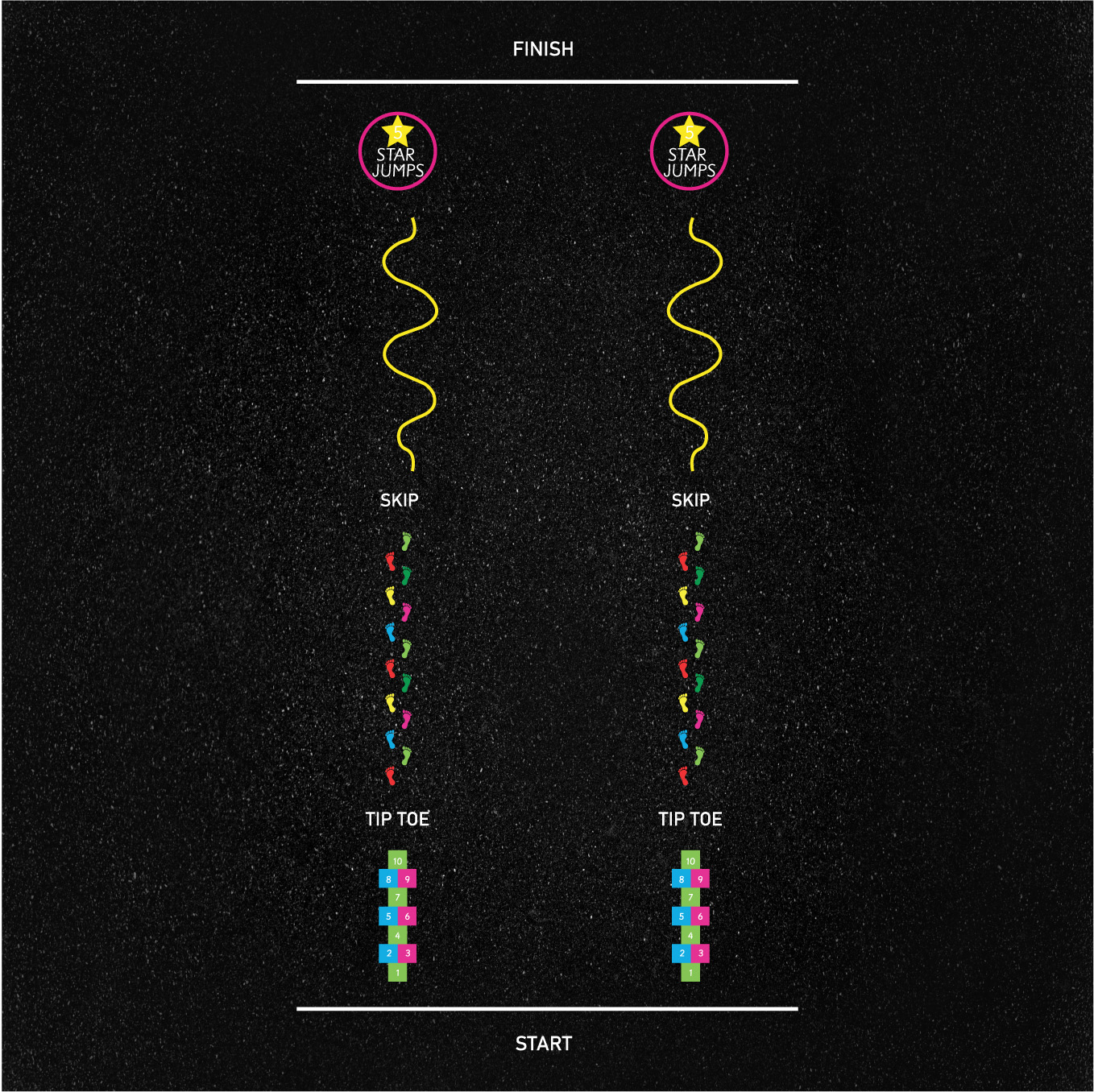
Fitness Test
Size: 16 x 8 m
£625.00 more details
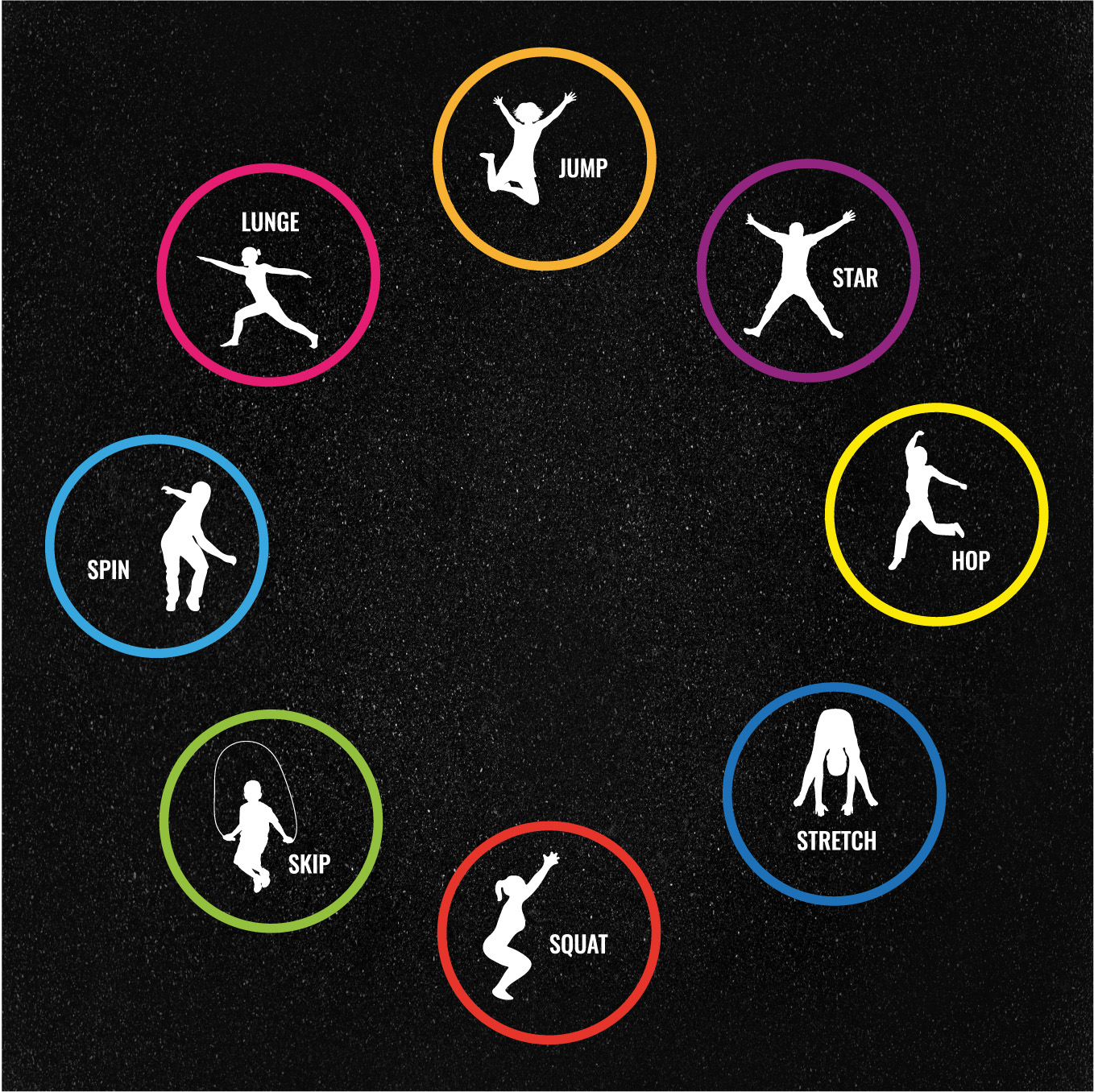
Fitness Circle
Size: 5.5m Diameter
£665.00 more details
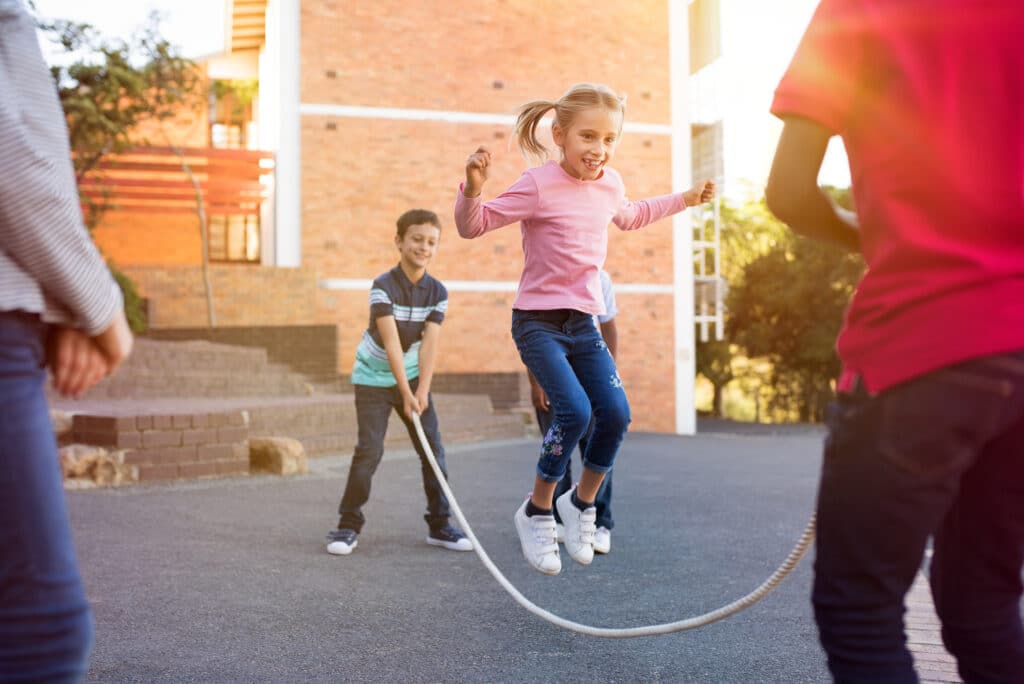
6. Long Rope Skipping
Number of Players: 3+
Age Range: 5+
What the Game Teaches: Team play, coordination, and rhythm.
How to Play the Game:
Jumping rope can be done in so many fun ways, it’s no surprise this retro game has stood the test of time so well!
One of the most popular school playground games worldwide, long rope jump skipping is a great activity for groups. All you need is a skipping rope and a team to play, too! Children can take turns skipping in and out of the rope, without stopping the game. Rhymes can be sung to keep everyone in time and the rope can be spun faster and faster to make the game harder.
Tips for Adults: If you want to play this game with your class, we would recommend two teachers swing the biggest jump rope available and you challenge your class to all jump together. They can either jump into the rope one at a time until you have the full class lined up, or you can all start jumping together at the same time. Jump rope is a lot of fun and a great group activity!
Time to Play: 15-30 minutes
7. Clapping Games
Number of Players: 2
Age Range: 5+
What the Game Teaches: Memorisation, coordination, and team play skills.
How to Play the Game:
This might not be much of a physical, energy-burning game, but clapping games have been around for decades and are still going strong in schools across the country. Clapping games require players to play in pairs, as most basic clapping rhythms require clapping your hands together, hands up, hands down, hands to the other person, and finally hands together.
A particularly popular hand clapping rhyme goes like this:
A sailor went to sea, sea, sea
To see what he could see, see, see
But all that he could see, see, see
Was the bottom of the deep blue sea, sea, sea
Players can repeat this as many times as they want, getting faster and faster until they simply can’t keep up. It’s great fun and an enjoyable game for groups of friends – especially girls and younger children.
Tips for Adults: This game can be adapted for big groups, with a number of pairs playing at the same time and children competing against each other.
Time to Play: 15-30 minutes in groups
Choose from 15 Easy Hand Clapping Games to Teach Your Kids
8. Duck, Duck, Goose
Number of Players: Minimum of 10
Age Range: 5+
What the Game Teaches: Engagement, team play, and fast reactions.
How to Play the Game:
One of the most popular games at children’s parties, Duck, Duck, Goose is a fun activity that keeps kids engaged, active, and playing as a team. This game involves children sitting in a large circle, facing inwards. One child is chosen to be the tapper and their job is to walk around the outside of the circle tapping each child on the head while saying, “Duck, duck, duck.”
At a point of their choosing, the tapping child will tap another child on the head and shout “Goose!” The goose then jumps up and chases the tapper around the circle before they sit down in the goose’s vacated spot. If the tapper catches the goose before they manage to sit down, the goose becomes the tapper. But if the goose escapes the tapper and sits down without being caught, the tapper has to play another round.
Tips for Adults: Although there is no age or number limit to Duck, Duck, Goose, this game tends to be more popular with younger children. So, if you’re a primary school teacher and you teach a Reception class or KS1, this game could be the perfect activity for your class.
Time to Play: 20 minutes (depending on group size)
9. The Big Ship Sails
Number of Players: 10+
Age Range: 7+
What the Game Teaches: Teamwork and memorisation.
How to Play the Game:
All players must hold hands to form a chain. The first two players at the end of the line must hold their hands up high to make an arch, while the players at the other end of the line dance through, keeping their hands joined at all times. This is known as ‘Threading the Needle’. Once they’ve reached the end of the line, an arch is made again, and the process starts over. The idea is to keep going for as long as possible without breaking the chain.
Tips for Adults: The origins of this game are unknown. However, some claim The Big Ship Sails first originated from the original ship used to sail down the Manchester Ship Canal in the 1800s. No matter its origins, The Big Ship Sails is a retro game every kid should learn because it requires an amazing amount of cooperation and teamwork.
Time to play: 30 minutes
10. Please, Mr. Crocodile
Number of Players: 30+
Age Range: 5+
What the Game Teaches: Self-awareness, speed, and patience.
How to Play the Game:
This game is a fun one for younger kids and is a great way of getting them thinking and making them aware of their surroundings. It can also be played with as many people as you like! One child has to be Mr. Crocodile and the other children form a row a few metres away, saying: “Please, Mr. Crocodile, can we cross your golden river?”. Mr. Crocodile then replies with something like: “Only if you’re wearing red.”
If you are wearing red, you take one step forward safely. If you are not wearing red, you must dodge the crocodile’s snaps while running for the safety zone. If you’re caught, you’re out. The first person to reach Mr. Crocodile is the winner and becomes Mr. Crocodile in the next game.
Tips for Adults: This game can be played with groups ranging both in numbers and in age.
Time to Play: One hour
11. Snake in the Gutter
Number of Players: 6+
Age Range: 5+
What the Game Teaches: Problem solving, teamwork, and agility.
How to Play the Game:
How the game is played really does depend on the number of kids playing. However, we would suggest you make at least 3 of the children the “snakes”. Have the snakes form the “gutter”. They can do this by standing in a line with wide spaces between them. The snakes should be facing the rest of the players, who should be at a distance.
The person in charge (either an adult or a child) yells, “Snake in the gutter!” and the children must attempt to run through the gutter without getting caught by a snake. Anyone who is caught becomes a snake and must stay in the gutter. Those who make it through without getting tagged must go again and again until everyone in the game has been caught.
Tips for Adults: This is a fun game for many children. However, some may feel scared at the thought of trying to run through the gutter. In this scenario, try to buddy them up with a friend to help them feel less vulnerable and make the game more fun.
Time to Play: One hour
12. Ready, Aim, Throw!
Number of Players: Minimum of 4 players
Age Range: 10+
What the Game Teaches: Effective communication and leadership skills.
How to Play the Game:
The object of Ready, Aim, Throw is to get a blindfolded person to throw a ball to another blindfolded player, and so on. Kids work in pairs (one blindfolded and the other not) and can help their blindfolded partners by effectively communicating with them, telling them when to duck, throw, catch, or move in a particular direction.
The partner who can see leads the blindfolded person by the arm. But, for a trickier version of the game, you can ban touching and only have partners lead others by giving talking instructions.
Tips to Adults: It’s best to play this game with foam balls to avoid any injuries – safety is important!
Time to Play: One hour
13. Tunnel Tag
Number of Players: 10+
Age Range: 5+
What the Game Teaches: Obedience, team play, social skills, and agility.
How to Play the Game:
Tunnel Tag is a game built off the simple concept of tag, in that it involves one person being the tagger and tagging other players. Any player tagged must then “freeze” in position. In order to be “unfrozen”, another child must crawl through the tagged child’s feet so that they can rejoin the game.
Tips for Adults: This game is great fun for everyone involved and can be played with kids of all ages at once. If you have a class full of children with lots of pent-up energy, Tunnel Tag is perfect.
Time to play: 30 minutes
14. Look Up, Look Down
Number of Players: 15-20
Age Range: 5+
What the Game Teaches: Good listening skills.
How to Play the Game:
Have all the players of the game form a large circle and stand roughly two feet apart from one another. Once all the players are standing where they should be, the moderator (usually a teacher) shouts out “Look up!”. All the players have to look up immediately and then look directly at another person in the circle. If two people lock eyes, they’re out.
All remaining players stand in their places and continue staring until the teacher says, “Look down”. The round then starts again until the two final players are left and crowned the winners.
Tips for Adults: This is a great game for getting the attention of your classroom, and certainly helps children to listen properly after they’ve become a bit noisy!
Time to Play: 15-30 minutes
15. Body Spellers
Number of Players: 9-15
Age Range: 10+
What the Game Teaches: Spelling and teamwork
How to Play the Game:
This game is quite simple really. Split the group into two teams, ensuring both teams have equal numbers. Next, give them instructions on how they are to spell a word (using only their fingers, hands, or body). Finally, give both teams the same word (no more than four letters) and give them 1-2 minutes to create the word amongst themselves. The first team to create a readable word that is also spelled correctly gets a point.
Tips for Adults: This game is a fantastic way to teach children how to spell and have them learn in a fun and exciting way. You can even make the teams bigger and choose longer, more difficult words for older children!
Time to Play: 30 minutes to an hour
16. Catch the Dragon’s Tail
Number of Players: 12-18
Age Range: 10+
What the Game Teaches: Teamwork.
How to Play the Game:
Catch the Dragon’s Tail is a great game to play in large groups and is fantastic for keeping kids active and playing well together! It requires children to form a long chain by holding hands – this chain must not be broken. The person at one end of the chain is the head and the person at the other end of the chain is the tail.
The aim of the game is for the head to catch the tail. All the players in the middle of the chain should try and stop the head from catching the tail, without breaking the chain – far easier than it sounds! If the head succeeds in catching the tail, the person playing the tail becomes the head and the game continues.
Tips for Adults: This game is great fun for all involved and a great way of encouraging teamwork, while also giving children an opportunity to exert some physical energy.
Time to Play: 30 minutes to an hour
17. The Hula Hoop Game
Number of Players: 30
Age Range: 7+
What the Game Teaches: Problem solving and teamwork.
How to Play the Game:
The Hula Hoop game helps children keep active during their break and lunchtimes, teaching them how to twist, turn, bend, and solve problems. The game is easy to play; all you have to do is slide a hula hoop onto someone’s arm and have everyone stand in a circle holding hands. The aim of the game is to move the hoop all the way around the circle without letting go of each other’s hands. It’s much harder than it seems!
Tips for Adults: This game can be played with groups of any size and all you need to play is one hula hoop.
Time to play: 1 hour
18. Simon Says
Number of Players: 30
Age Range: 5+
What the Game Teaches: Listening skills
How to Play the Game:
Simon Says is a popular game in schools around the country. The rules are simple, too; one player is “Simon” and they give the instructions. The rest of the group follow. When the group leader says, “Simon Says,” and gives an instruction, the players have to do the action (for example: “Simon says, hop on one leg”).
If the leader gives an instruction such as “Clap your hands” but does not say “Simon says” first, those who carried out the action are out of the game. The last player standing wins the round and gets to be the next Simon.
Tips for Adults: This is a great game for preschool kids as it teaches them to follow directions.
Time to play: 1 hour.
19. Capture the Flag
Number of Players: 30+
Age Range: 10+
What the Game Teaches: Teamwork, agility, speed, and problem solving.
How to Play the Game:
Divide the group into two teams and let them attempt to catch each other’s flags without being caught on the other team’s territory. The aim of the game is to capture the other team’s flag and bring it back to your team’s territory. The concept is simple, but the more kids there are playing the game, the more difficult the objective becomes!
Tips for Adults: This is a great game for older children and can be played both inside and outside, as long as you have a big enough space. All you need to play this game is two flags (preferably different colours), but if you can’t find flags, socks are also a great option!
Time to play: 1 hour
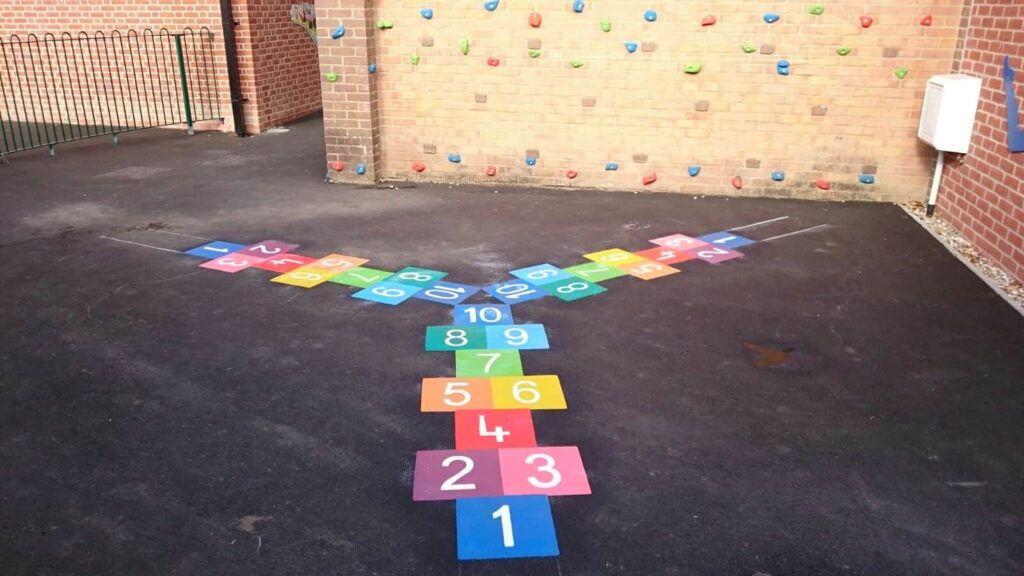
20. Hopscotch
Number of Players: 1
Age Range: 5+
What the Game Teaches: Counting, balance, and coordination.
How to Play the Game:
Hopscotch is a ready-drawn diagram on the ground of numbered squares. The player throws a bean bag onto one of the squares and has to follow the hopping pattern, missing the square with the beanbag on it. A standard hopscotch diagram will require children to do single hop, a double hop, single, double, and another single and another double before turning around at the last single (which is often marked with the number 10). This is an easy game for everyone to learn and great fun to play!
Tips for Adults: Although Hopscotch can be played with others, it is generally a game played by one person at a time (with classmates cheering on from the sidelines).
Time to play: 15 minutes
Choose Fantastically Fun Hopscotch Designs
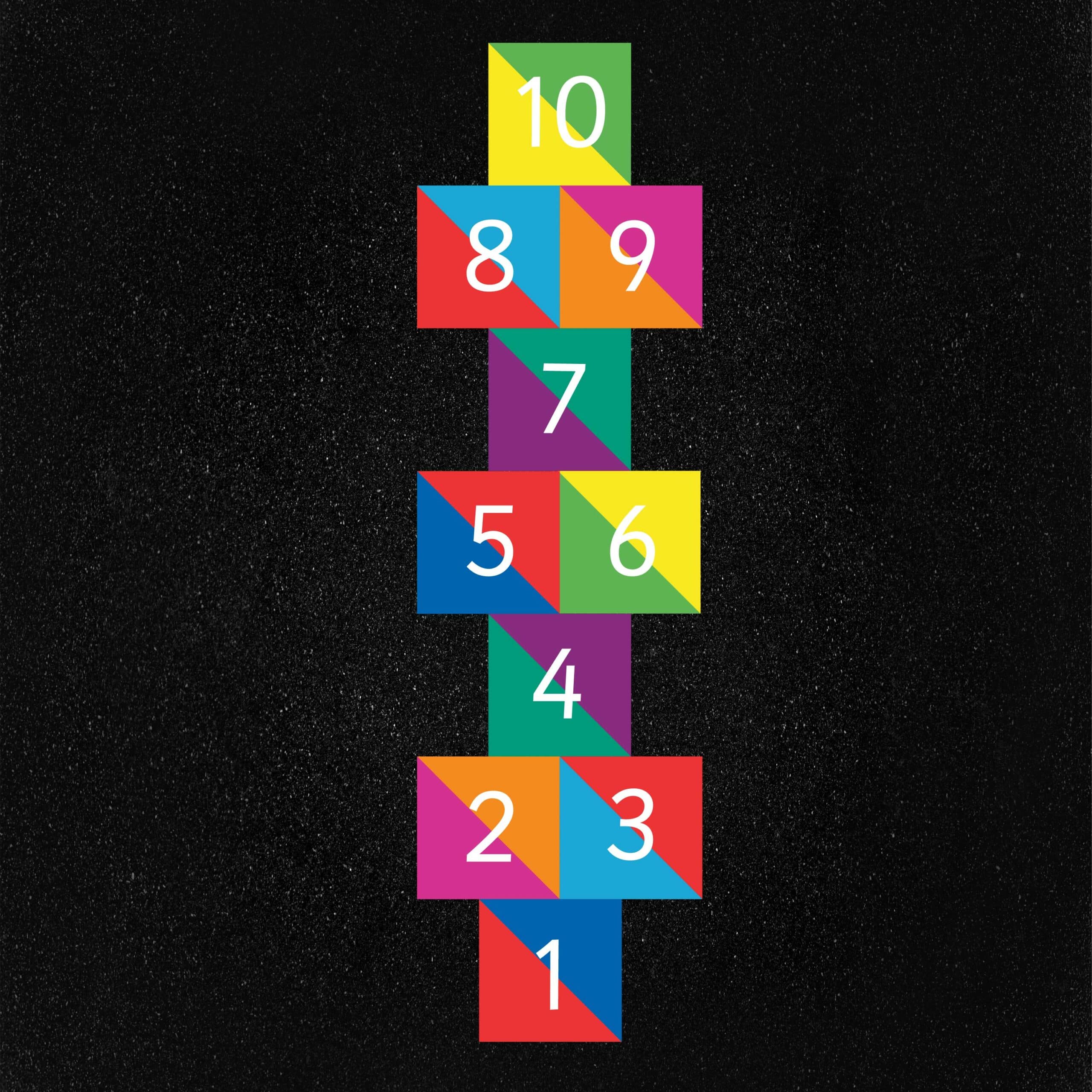
Diagonal Hopscotch
Size: 2.1 x 0.6m
more details

Language Hopscotch
Size: 4.3 x 4.3m
£750.00 more details

Splash Hopscotch
Size: 2 x 0.8m
£250.00 more details
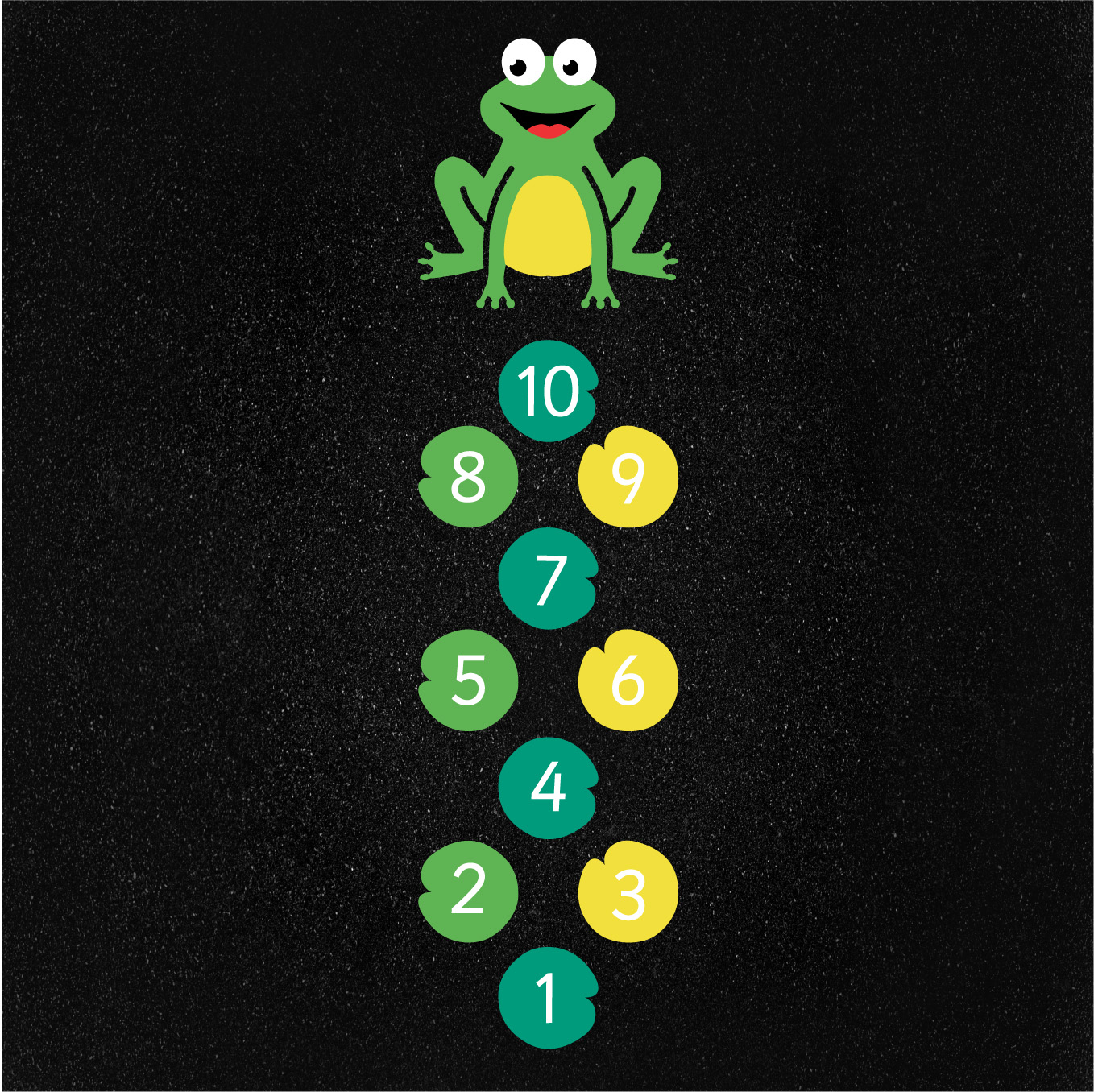
Frog Hopscotch
Size: 3 x 0.8m
£250.00 more details

I AM Hopscotch
Size: 2.5 x 1m
£550.00 more details
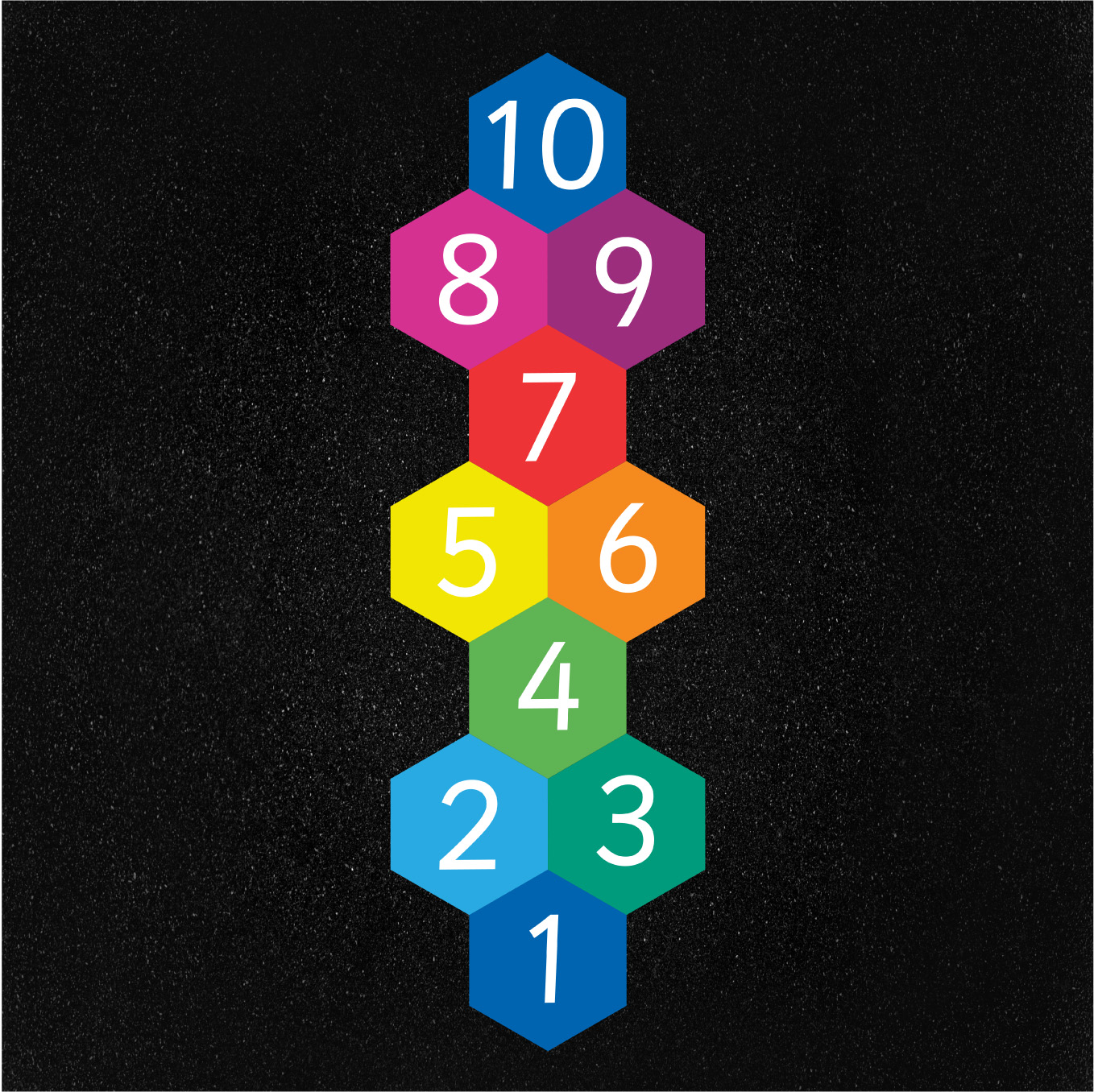
Hexagon Hopscotch
Size: 1.5 X 0.6m
£175.00 more details
21. Snake Bite or Helicopter
Number of Players: 10+
Age Range: 7+
What the Game Teaches: Balance, coordination, and agility.
How to Play the Game:
To play the game, one person stands in the centre of the circle of players and spins a jump rope, from one end, around on the ground. The players have to jump over the rope as it comes around. Any players that are hit with the rope are immediately out and the winner is the last person standing.
Tips for Adults: Safety should be your main concern while playing this game. Ensure the spinning rope is always kept close to the ground to avoid injury.
Time to play: 1 hour
22. Limbo
Number of Players: 10+
Age Range: 10+
What the Game Teaches: Agility, flexibility, and balance.
How to Play the Game:
One of the most popular party games out there, Limbo is also great fun in the playground! Two players must hold either end of a rope up and players must pass underneath it by bending backwards. Each round the rope is lowered ever so slightly until the players fall while trying to go underneath the rope.
Tips for Adults: Be wary of children who struggle with balance, as this game can be a challenging one and you don’t want anyone to hurt themselves.
Time to play: 30 minutes.
23. Dodgeball
Number of Players: 30+
Age Range: 10+
What the Game Teaches: Coordination and reflexes.
How to Play the Game:
Dodgeball is a popular game among young children, especially those who are particularly active. Every player has a ball and the goal is to hit your opponents with the ball while dodging balls thrown by the opposite team. If you catch a ball that’s thrown at you, the person who threw it is out of the game.
Tips for Adults: This game is extremely fast-paced and with rules (such as no aiming at people’s heads), the game is generally great fun and pretty safe!
Time to play: 1 hour
24. Piggy in the Middle
Number of Players: Minimum of 3
Age Range: 8+
What the Game Teaches: Catching skills, coordination, and communication.
How to Play the Game:
The aim of Piggy in the Middle is to throw the ball to each player without the person in the middle catching it. Once the person in the middle catches the ball, the person who threw it last takes the middle spot instead.
Tips for Adults: If you’re playing this game with younger children, you can put a time limit on the time spent in the middle of the circle – it’s especially helpful for children who aren’t yet good at catching.
Time to play: 1 hour
Discover Our Piggy in the Middle Design

25. Blind Man’s Bluff
Number of Players: 10+
Age Range: 6+
What the Game Teaches: Problem solving.
How to Play the Game:
Blindfold one child out of the group, spin them around a few times to disorientate them, and then tell them to catch another child and tag them.
Tips for Adults: It is best to have an adult or two watching the blindfolded child to ensure they do not walk into a wall or fall over and get hurt.
Time to play: 1 hour
26. Cat Catching Mice
Number of Players: 10+
Age Range: 5+
What the Game Teaches: Agility and teamwork.
How to Play the Game:
One child is chosen to play the “cat” (otherwise known as the “chaser”) and the other child is chosen to be the “mouse” (the one being chased). All the other players form a circle by holding hands with the mouse inside the circle and the cat outside the circle.
The children in the circle call out the following rhyme:
“What time is it?”
“Just struck nine.”
“Is the cat at home?”
“He’s about to dine.”
When the rhyme stops, the children stop moving around in a circle and the cat starts to chase the mouse, both weaving in and out of the circle. However, the rule is that the cat has to follow the mouse’s path. When the cat catches the mouse he can pretend to “eat” him for fun, before two more children take a turn.
Tips for Adults: This game can be played with children of most ages and is great fun for all involved.
Time to play: 1 hour
27. French Cricket
Number of Players: A minimum of 6 players.
Age Range: 10+
What the Game Teaches: Teamplay and coordination.
How to Play the Game:
Players must stand in a circle and choose somebody to bat first. The batter stands with their feet together defending their legs, below the knees. The players in the circle must ‘bowl’ at their legs and they have to hit the ball away. If the batter successfully hits the ball, they are allowed to move their feet and turn to face in another direction. However, if they miss the ball, they have to twist and turn to defend the stumps without moving their feet.
If the batter gets hit with a ball, they’re out. The batter also goes out if they hit the ball back at a bowler and they catch it before it bounces.
Tips for Adults: This game is best played with a soft ball, to avoid injury.
Time to play: 1 hour
28. Hunter and Guard
Number of Players: 30
Age Range: 10+
What the Game Teaches: Speed, agility, and teamwork.
How to Play the Game:
Hunter and Guard is a great game for large groups of energetic children. One fast player is chosen to be the “hunter” and another is chosen to be the “guard”. The rest of the children play the “animals”.
A circle needs to be marked out on the ground with chalk to create the pen – the guard stands in this area for the entirety of the game. The children playing the animals scatter around the playing area and try to escape the hunter, who chases after them. If the hunter catches a child, he leads them over to the pen. Once in the pen, you cannot escape unless you are rescued by another animal tagging you.
Tips for Adults: You can stop this game at any time, but it can go on for ages if you do not set a limit. A good idea is to set a challenge for the hunter to catch a certain number of animals before the timer goes off, or before the end of the game. It’s an especially good game for children who don’t like running because you can keep them involved by putting them in the guard position, so they can still catch the animals but they can only run around a small perimeter to do it.
Time to play: 1 hour.
29. Where Do You Stand?
Number of Players: 30
Age Range: 5+
What the Game Teaches: Listening and decision-making skills.
How to Play the Game:
Draw a line with chalk on the playground and have all the children start by standing on the line. Now, call out opposites and point in one direction of the line for each. The players must make up their minds as to which side of the line they want to stand on. Some good examples are: cats or dogs, burgers or hot dogs, beach or pool, macaroni cheese or lasagne.
Tips for Adults: You can adapt the choices to make them more difficult or relevant for particular age groups, but this is generally a game that works for all ages.
Time to play: 30 minutes
30. Hens and Chicks
Number of Players: 30
Age Range: 7+
What the Game Teaches: Listening skills and speed.
How to Play the Game:
Have all the children line up on one side of the playground, nominate someone to play the “hen”, and have them stand in the middle of the playground a good distance from the other players. The hen’s job is to call her “chicks”. When the hen calls her chicks, all players must run from one side of the playground to the other without getting caught. If you’re caught by the hen, you join her in the middle. The last uncaught player is the winner and becomes the hen for the next game.
Tips for Adults: This game can be played with children of all ages and is a great way to let them get rid of that extra energy.
Time to play: 1 hour

31. Leapfrog Races
Number of Players: 10+
Age Range: 5+
What the Game Teaches: Agility, balance, and teamwork.
How to Play the Game:
Leapfrog is played by splitting a group of players into two so they can compete against each other in teams. When you say “go”, the two teams of leap froggers take off across the field, each player hopping over his teammates and then crouching down to be hopped over. The first team to cross the finish line wins the race.
Tips for Adults: This game can be played multiple times to tire the kids out. For example, you could decide to play multiple rounds and say the first team to reach five wins.
Time to play: 30 minutes
32. Jeep Safari
Number of Players: 30
Age Range: 10+
What the Game Teaches: Listening skills and problem solving.
How to Play the Game:
Jeep safari is similar to musical chairs, except that it’s more of an outside version. You can use rocks, jumpers, and toys, setting them up around the playground and telling the kids they’re on safari. Players have to keep jumping, hopping, walking, skipping, and running around the playground until you say “A lion’s on the loose!”, at which point they have to get to a “Jeep” (one of the items on the playground) as soon as possible.
The player who doesn’t make it to a jeep on time gets eaten by the lions and is out of the game. A jeep is removed each round and the game continues until only one child is left.
Tips for Adults: You can get really creative with this game and put multiple objects you can find around the playground. Make the rules harder by banning objects of certain colours in each round – there are so many possibilities!
Time to play: 1 hour
33. Four Square
Number of Players: 4
Age Range: 10+
What the Game Teaches: Kicking and throwing a ball.
How to Play the Game:
Four Square is typically played with a rubber ball to avoid injury. The objective of Four Square is for players to eliminate other players. Each player occupies a quarter of the court and the ball is bounced between players using only their hands, until one player makes an error and is eliminated. Players cannot catch, carry, or hold the ball at any time during play.
Tips for Adults: The rules for this game can change, depending on the age of the players and the complexity required. However, it is a fun game for all involved and can easily involve more players if those eliminated switch places with another person waiting on the sidelines.
Time to play: 1 hour
Brighten Up Your Playground with Colourful Four Square Designs
34. Marco Polo
Number of Players: 30
Age Range: 10+
What the Game Teaches: Listening skills and quick reactions.
How to Play the Game:
This is a game commonly played in a swimming pool, but it can also be played on a playground. Everyone stands together in a group and one person closes their eyes and counts to ten. As they count, the other players must scatter around the playground. Once they’ve reached ten, the person says, “Marco”, and everyone must reply “Polo”. The leader then has to catch as many people as they can.
Tips for Adults: This game is exceedingly easy to organise and is made even more difficult for kids if they cannot go out of bounds of the playground markings.
Time to play: 1 hour.
35. Sardines
Number of Players: 10+
Age Range: 5+
What the Game Teaches: How to stay quiet, teamwork, and problem solving.
How to Play the Game:
Sardines is a slightly harder version of hide-and-seek, as it is played as a team. One person is designated to hide while everyone else counts. Everyone searches for the hidden person at once. The first person to find the hider joins them, and so on and so forth. The last person to find everyone hidden together loses the game.
Tips for Adults: This game is great fun for a big group of people – especially if the hiding places are hilariously small and can only fit a couple of people in at one time! It’s also great for children’s problem solving and critical thinking, as they try to find ways to make themselves fit or to find nearby hiding spots.
Time to play: 30 minutes
36. Red Light/Green Light
Number of Players: 3+
Age Range: 5+
What the Game Teaches: Speed, reflexes, and agility.
How to Play the Game:
A similar stop-and-go action to games like Safari Jeep and Musical Chairs, this game involves one player, sometimes called the “police officer” or “traffic officer”, standing on the outskirts of an area, usually next to a wall and facing away from the rest of the group. All the other children taking part must then head towards them, stopping stock still when the traffic officer turns round and calls out “Red light!”.
If any kids move after “red light” has been called, they are out of the game. “Green light!” is called when the officer has turned back around again to continue the game. Players win the game by making it to the traffic officer, either by stepping over a line or touching the wall.
There are many variations on who will be the next traffic officer, but it’s often the first person to win the game.
Tips for Adults: You should usually use a wide open space for this game, and depending on the size of the area you have it may be necessary to have more than one pupil play the traffic officer role. This makes it less likely that kids will get away with moving, and makes it more challenging.
Time to play: 30 minutes
37. Three Flies Up
Number of Players: 30
Age Range: 10+
What the Game Teaches: Catching and coordination skills.
How to Play the Game:
Nominate one person to be the thrower and everyone else to be catchers. The thrower has to stand 50 feet away from the catchers and throw the ball up in the air towards the catchers. If you catch the ball, you get a point. The first person to reach three points becomes the thrower. It really is that simple!
Tips for Adults: Use a soft ball.
Time to play: 30 minutes

38. The Obstacle Course
Number of Players: 30
Age Range: 10+
What the Game Teaches: Coordination and agility.
How to Play the Game:
The playground obstacle course is a simple game that involves giving kids multiple directions to follow and tasks to complete. You can create an obstacle course for all abilities and ages and have children climb monkey bars, walk balance beams, skip, hop, jump, and bounce a ball to the finish line.
The obstacle course is a great way to help children work on their fine motor skills, as well as honing their sense of direction and ability to follow directions.
Tips for Adults: You can make the obstacle course as easy or hard as you like, depending on the abilities and sporting levels of the children you teach.
Time to play: 1 hour
39. Wheelbarrow Races
Number of Players: A minimum of 4 children to play.
Age Range: 10+
What the Game Teaches: Strength, balance, and communication.
How to Play the Game:
Have two children work as a team and race against other pairs in a wheelbarrow race! One child in the pair holds the legs of the other child as they walk on their hands to the finish line as fast as they can. The first pair to the finish line wins the race. Don’t be fooled, however; the wheelbarrow race can be extremely physically exerting.
Tips for Adults: Wheelbarrow races are a great way to encourage team sportsmanship in children. If you’d like it to be as safe as possible, though, you might consider doing it on a designated safety surface, such as a stretch of artificial grass.
Time to play: 15-30 minutes
40. Ring a Ring o’ Roses
Number of Players: 10+
Age Range: 5+
What the Game Teaches: This game teaches memorisation and teamwork.
How to Play the Game:
Players stand, or sometimes skip in a circle while holding hands and singing this rhyme:
A ring a ring a’ roses,
A pocket full of posies,
A tissue, a tissue
They all fall down.
When the kids sing the words “they all fall down,” everyone has to collapse on the ground.
Tips for Adults: The number of children playing this game does not matter; it can be played with as many or few available. As with wheelbarrow races, you might also consider playing this on a soft surface such as artificial grass – you don’t want anybody getting hurt, after all!
Time to play: 15-30 minutes.
41. Queenie
Number of Players: 30
Age Range: 10+
What the Game Teaches: Throwing and catching skills and hand-eye coordination.
How to Play the Game:
One player is picked to be “Queenie”, and that person turns their back on all the other players. Queenie throws the ball over their shoulder and back towards everyone else. When the ball is thrown back towards the other players, they have to catch it or pick it up. Then, all the players put their hands behind their backs so Queenie doesn’t know who has the ball.
Queenie then turns around and the others shout:
“Queenie, Queenie, who’s got the ball?
Are they short, or are they tall?
Are they hairy, or are they bald?
You don’t know because you don’t have the ball!”
Queenie’s job is to guess who has the ball by a process of elimination. If the person with the ball is last to be picked, they become the new Queenie.
Tips for Adults: Play this game with a soft ball to avoid injury.
Time to play: 1 hour
42. Spud
Number of Players: 30
Age Range: 10+
What the Game Teaches: Teamwork.
How to Play the Game:
Spud is played on a large playing field. One child is chosen to be “It”. This child’s job is to close their eyes and count to ten, as the other children run away as fast as they possibly can. Once the leader has reached the number 10, the other children have to freeze on the spot. The child who’s It is then allowed to take four giant steps towards the child nearest to them, where they’re then allowed to try and hit them with a softball.
If the child is hit with the ball, that child becomes It and also receives the letter S. Once a player has received an S, P, U, and D, that player is out. The winner of the game is the last person standing.
Tips for Adults: Play this game with a soft children’s ball on a playing field.
Time to play: 1 hour
43. Flinch
Number of Players: 30
Age Range: 10+
What the Game Teaches: Endurance and patience.
How to Play the Game:
This game is played similarly to dodgeball and is ideal for children who are brave and don’t easily flinch. One player is chosen to be It, and they take possession of the ball. The other players have to line up and fold their arms and the player who is It can either throw the ball at the others or pretend to in an effort to make them flinch.
The players standing in a line must not unfold their arms or move when the throwing player throws the ball. However, the players must attempt to catch the ball when it is thrown at them. If they fail to catch the ball, or they flinch, they earn an F. Once a child has earned all the letters to spell FLINCH, they are out of the game. The last player standing is a winner.
Tips for Adults: This game must be played with a softball.
Time to play: 1 hour.
44. Say and Catch
Number of Players: 30
Age Range: 10+
What the Game Teaches: Memorisation and catching skills.
How to Play the Game:
Before play begins a category is chosen – animals, for example. Players stand in a circle and throw the ball to one another. The idea is that players have to say the name of an animal before they catch the ball. If they fail to come up with an answer, or they miss the ball that is thrown at them, or they name an animal that has already been named, they are out of the game. The last player standing is the winner.
Tips for Adults: This game is great because it helps improve a child’s reaction times, while also boosting cognitive thinking.
Time to play: 1 hour
45. Dog and Bone
Number of Players: 5+
Age Range: 4+
What the Game Teaches: Patience and teamwork.
How to Play the Game:
One child plays the role of the “dog” and sits on a chair, blindfolded. The “bone”, which can be any object you want it to be, is placed underneath the chair. The players stand around the chair in a circle.
One child is chosen to play the role of the leader; it’s their job to gesture to a child to try and take the bone from underneath the chair. However, the difficult aspect comes in when the child has to steal the object without making any sound or alerting the dog. If the dog hears the child sneaking up on them and barks in their direction, that child must return to their spot in the circle.
However, if a child successfully steals the bone without the dog noticing, all the children in the circle must put their hands behind their backs and the dog must guess who took the bone (their blindfold can be off at this point). If the dog guesses correctly, gameplay continues. If not, a new dog is chosen and the game restarts.
Tips for Adults: If all children want to play, you can play the role of the leader.
Time to play: 1 hour.
46. Michelangelo’s Madhouse
Number of Players: 5+
Age Range: 10+
What the Game Teaches: Balance.
How to Play the Game:
This game has many different names, but it’s a simple concept. Whoever is “Michelangelo” takes each of the other players by the hands and spins them all around several times before letting them go. The players have to freeze in the position they land in. This part of the game doesn’t really affect the playing, so kids can be as silly with the positions they end up in as they like.
After everyone has frozen like statues in their positions, Michelangelo walks around trying to make the players laugh without touching them. The first person to giggle plays Michelangelo in the next game.
Tips for Adults: This game should be played on a soft, grassy area so that when children fall, they do not hurt themselves.
Time to Play: 1 hour
47. Water Jumping
Number of Players: 10+
Age Range: 5+
What the Game Teaches: Coordination and timing.
How to Play the Game:
In this game, all players stand in a circle holding cups full to the brim with water. Nominate one person to stand in the centre of the circle and spin a rope close to the ground. All the players have to jump over the rope without spilling the water from their cups. Whoever has the most water left in their cup at the end of five jumps wins.
Tips for Adults: This game can get wet, so it’s best to play it outside rather than in a sports hall.
Time to Play: 30 minutes.
48. Hitchy Dobber
Number of Players: A minimum of two.
Age Range: 7+
What the Game Teaches: Balance and coordination.
How to Play the Game:
This game is played in pairs. Two children face each other and hop around on one foot. The children can bump each other gently but not push the other over. The last person standing wins the game and goes on to play a new opponent.
Tips for Adults: This game can be played with pairs playing against each other and the winners from each game facing off against one another.
Time to Play: 30 minutes.
49. Port or Starboard
Number of Players: 30
Age Range: 5+
What the Game Teaches: Listening skills.
How to Play the Game:
This is one of our favourites, simply because players get to pretend they’re on a pirate ship! One child is the “captain” and should out instructions such as “Port” (run to the left), “Starboard” (run to the right), “Climb the rigging”(pretend to climb a ladder), “Sweep the decks” (pretend to scrub the ground), and so on. The slowest person to carry out the commands or the person who gets the command wrong is out. Last one standing wins the game.
Tips for Adults: We highly recommend this game for especially large groups – it’s also a great way to get the attention of a whole room!
Time to Play: 30 minutes.
50. Up and Down
Number of Players: 5+
Age Range: 6+
What the Game Teaches: Catching and throwing skills.
How to Play the Game:
Get the players to stand in a circle and pass the ball around. If a player drops the ball or misses a catch, they have to go down onto one knee. If they catch the ball on their next go, they are allowed to stand up again. However, if they miss the ball again they have to go down onto both knees, then one elbow, then two elbows, then chin, and finally out!
Tips for Adults: This is a fantastic game for large groups and great fun for everyone. It’s also entertaining for the kids and helps them to practise critical thinking alongside coordination, as they work out how to catch the ball with one hand.
Time to Play: 30 minutes
51. Jailbreak
Number of Players: 30
Age Range: 5+
What the Game Teaches: Teamwork, speed, and agility.
How to Play the Game:
Choose an area, such as a tree, to be the “jail” and then nominate two or three players to be the “jailers”. The jailers count to 20 while all the other players find a place to hide. Once 20 seconds is up, the jailers open their eyes and have to find, chase, and tag the other children.
If a child is caught, the jailer can take them to jail. A child can only break free from jail when another child manages to touch the jail without being caught by a jailer. This causes a “jailbreak” and everyone who was in jail is immediately freed. The game is only won when every player has been jailed.
Tips for Adults: This game can go on for hours, so set the kids against a timer and give them a target to jail 5 children in 3 minutes.
Time to Play: 1 hour.

Why Group Sports are Important for Kids
Nicola Butler, the Chair of Play England, states that: “traditional playground games are vital for children’s health, wellbeing and development. Playing these games allows children to learn about friendships (falling out, making up, negotiating and resolving disputes, making the game fun and fair) but most importantly being involved in these games make children happy.” – Huffington Post
Team building matters, it’s as simple as that, and group sports are a great way to teach children to play as a team. It’s your job as a teacher to provide children with the opportunity to play sports and develop their team-building skills in a fun environment.
Playground Games for Primary Schools
How you go about providing your pupils with the opportunities they need is between you and the curriculum, of course, but you might want to start deciding the most appropriate games for your pupils by looking at which ones are best for their age group. This might mean looking at games in terms of which ones are safest, which ones require the most developed coordination, and which ones may require more developed maths, literacy, or other skills.
To help you get started with this, we’ve separated some of the games above into the Key Stage levels they’re best for:
Playground Games for Reception Classes
A Reception class on the Early Years Foundation Stage (EYFS) curriculum will have three prime areas of learning:
- Communication and Language
- Personal and Social Development
- Physical Development
And four specific areas of learning through:
- Expressive Arts and Design
- Literacy
- Mathematics
- Understanding the World
To help your Reception class develop these when they’re out in the playground, you may then consider playground games such as:
- Clapping games
- Dog and Bone
- Duck, Duck, Goose
- Hopscotch
- Leapfrog races
- Please, Mr Crocodile
- Relay races
- Sardines
- Simon Says
Playground Games for KS1
KS1 classes will, of course, have moved on from EYFS and be working on their first years of the National Curriculum. However, it is still important for them to carry on developing the skills started in their Reception class, expanding on them and building on what they already know to take them to the next level. This may mean playing games with them such as:
- The Agility Course
- Blind Man’s Bluff
- Hens and Chicks
- Hitchy Dobber
- Hula hoop games
- Long rope skipping
- Ring a Ring o’ Roses
- The Big Ship Sails
- Up and Down
Playground Games for KS2
Moving on to KS2 will obviously result in another shift in students’ learning – Year 3s are the new Juniors now, after all! There will be an increased focus on spelling, creativity (especially in writing), and more advanced mathematics, as well as continued development of teamwork and leadership, critical thinking, and problem solving. You’ll already know that these have to be expanded upon and worked on more as they head through Years 4, 5, and 6.
As a result, you may want to play some of these games with your KS2 class:
- Basketball
- Body Spellers
- Capture the Flag
- Catch the Dragon’s Tail
- Four Square
- Michelangelo’s Madhouse
- Ready, Aim, Throw!
- Say and Catch
- Tug-of-War
It’s Important to Invest in Children Now
Bringing kids closer together allows them to develop social skills, invest in a shared outcome (winning or losing), and encourages them to support each other as a team. Many of the skills and values children learn at such a young age will stay with them into adulthood. So, it’s important you teach them good things and provide the environments in which they can learn how to play well in a team and respect one another.


